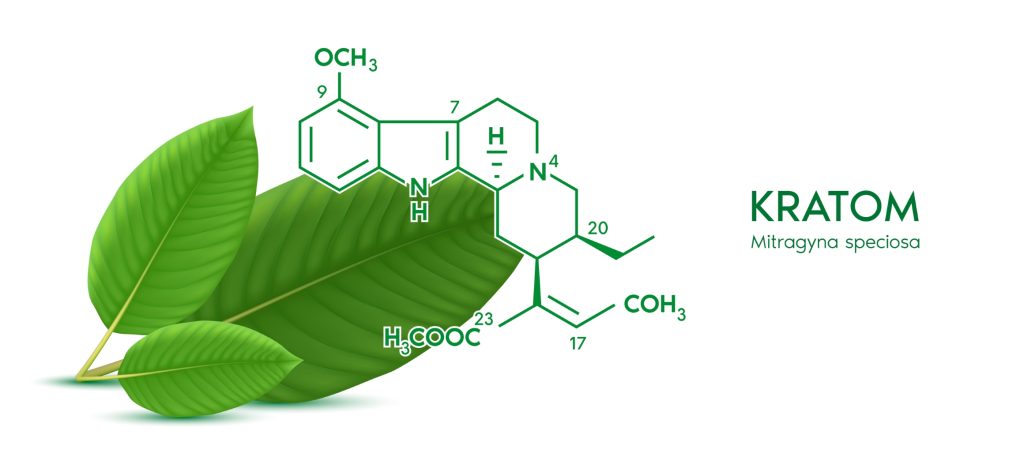By state
By City
Kratom: The "Natural" Substance with Opioid-Like Risks and the Need for Detox
Kratom is a substance derived from a tropical tree native to Southeast Asia. It’s often marketed as a “natural” alternative to opioids for pain relief, mood enhancement, and even as a way to manage opioid withdrawal.
However, this “natural” label is misleading.
Kratom acts on opioid receptors in the brain, and while it may not be a traditional opioid, it carries many of the same risks, including dependence, addiction, and potentially serious side effects. This page will explore what kratom is, how it’s used, its effects, the substantial dangers associated with its use, and the importance of medically supervised detox for those struggling with kratom dependence.

What is Kratom?

Kratom is a tree in the coffee family. Its leaves contain several active compounds, most notably mitragynine and 7-hydroxymitragynine. These compounds interact with opioid receptors in the brain, producing effects that vary depending on the dose. Kratom is typically consumed in the following ways:
- Leaves: Chewed fresh or dried or brewed into tea.
- Powder: The most common form in the US; made from dried and ground leaves. It can be mixed with water, juice, or other beverages, or put into capsules.
- Extracts: Concentrated forms of kratom, often sold as liquids, resins, or tinctures. These are significantly more potent than the leaf or powder.
- Capsules: Pre-measured doses of kratom powder.

How Does Kratom Work?
Kratom’s effects are primarily due to the action of mitragynine and 7-hydroxymitragynine on opioid receptors, particularly mu-opioid receptors (the same receptors targeted by drugs like morphine, heroin, and fentanyl). However, kratom’s interaction with these receptors is complex and not fully understood. It’s believed to act as a partial agonist at mu-opioid receptors, meaning it activates them but to a lesser extent than full agonists like morphine. This partial activation is thought to be responsible for some of kratom’s unique effects.
At low doses (typically 1-5 grams of powder), kratom tends to have stimulant-like effects:
- Increased energy and alertness
- Sociability
- Reduced fatigue
- Mild euphoria
At higher doses (typically 5-15 grams or more), kratom’s effects become more opioid-like:
- Pain relief (analgesia)
- Sedation and relaxation
- Euphoria
- Constipation
- Itching
- Nausea
The Dangers of Kratom Use
Despite being marketed as a “natural” and “safe” alternative, kratom carries significant risks:
Dependence and Addiction: Regular kratom use can lead to physical dependence, meaning the body adapts to the presence of the drug and withdrawal symptoms occur if it’s stopped abruptly. Addiction, characterized by compulsive drug-seeking and use despite negative consequences, is also a serious risk.
Withdrawal Symptoms: Kratom affects a number of receptors and pathways in the central nervous system. Withdrawal from Kratom can manifest in various ways. The most common and potentially least pleasant symptoms mimic that of opioid withdrawal. Symptoms can include:
- Muscle aches and pains
- Restlessness and agitation
- Anxiety and irritability
- Insomnia
- Runny nose and eyes
- Sweating
- Nausea, vomiting, and diarrhea
- Cravings
- Depression
- Hot and cold flashes
Liver Toxicity: There have been reports of liver damage associated with kratom use, particularly with long-term, heavy use. Symptoms can include jaundice (yellowing of the skin and eyes), dark urine, and abdominal pain.
Seizures: Although rare, seizures have been reported in association with kratom use, particularly at high doses or when combined with other substances.
Psychosis: In some cases, kratom use has been linked to psychotic symptoms, such as hallucinations, delusions, and paranoia.
Cardiovascular Effects: Kratom can cause rapid heartbeat (tachycardia), high blood pressure (hypertension), and other cardiovascular problems.
Respiratory Depression: While less common than with full opioid agonists, respiratory depression (slowed or stopped breathing) can occur with kratom, especially at high doses or when combined with other central nervous system depressants.
Contamination: Kratom products are largely unregulated, meaning they may be contaminated with other substances, including heavy metals, bacteria (such as Salmonella), or other drugs.
Drug Interactions: Kratom can interact with other medications, including prescription drugs, over-the-counter medications, and herbal supplements. These interactions can be dangerous.
Signs of Kratom Dependence/Addiction
- Using kratom more frequently or in larger amounts than intended.
- Unsuccessful attempts to cut down or control use.
Strong cravings for kratom. - Using kratom despite negative consequences (relationships, work, health).
- Neglecting responsibilities due to kratom use.
- Developing tolerance (needing more kratom to achieve the same effect).
- Experiencing withdrawal symptoms when not using kratom.
- Spending a significant amount of time obtaining, using, or recovering from kratom.


Kratom Detox: Why It's Necessary
While kratom withdrawal is not considered life-threatening, it can be extremely uncomfortable and distressing, leading to a high risk of relapse. A medically supervised kratom detox is highly recommended for several reasons:
Managing Withdrawal Symptoms: A detox program provides a safe and supportive environment where withdrawal symptoms can be managed with medications and supportive care.
Medications may include:
Buprenorphine: Acts as a partial agonist at the mu opioid receptor that assists with opiate withdrawal, as well as an antagonist at the Kappa opioid receptor reducing cravings.
Clonidine: An alpha-2 adrenergic agonist that helps with many withdrawal symptoms.
Benzodiazepines: (Used cautiously and short-term) to manage anxiety and agitation.
Anti-nausea Medications: To relieve nausea and vomiting.
Over-the-Counter Pain Relievers: For muscle aches and headaches.
Preventing Relapse: The intense cravings and discomfort of withdrawal make relapse highly likely without professional support. Detox provides a structured environment and helps individuals develop coping skills to manage cravings.
Addressing Co-Occurring Disorders: Many people who use kratom also have underlying mental health conditions, such as anxiety, depression, or PTSD. Detox provides an opportunity to assess and address these issues.
Medical Monitoring: Although serious medical complications are less common than with some other substances, medical monitoring is still important to ensure safety and address any potential problems.
Transition to Further Treatment: Detox is typically the first step in a comprehensive treatment plan. It prepares individuals for further therapy (residential or outpatient) and support groups.

Treatment After Detox
Following detox, continued treatment is crucial for long-term recovery. This typically includes:
Therapy: Cognitive-behavioral therapy (CBT), motivational interviewing, and other therapies help individuals address the underlying causes of their addiction, develop coping skills, and change their behavior.
Support Groups: 12-step programs and other support groups provide peer support and encouragement. SMART Recovery is another option.
Aftercare Planning: Developing a plan for ongoing support and relapse prevention is essential.
Conclusion
Kratom, despite its marketing as a “natural” alternative, carries significant risks of dependence, addiction, and various adverse health effects. Its opioid-like properties make it a potentially dangerous substance, and withdrawal can be extremely challenging. If you or someone you know is struggling with kratom use, seeking professional help, including a medically supervised detox, is the first and most important step towards recovery. Long-term recovery is achievable with the right treatment and support.